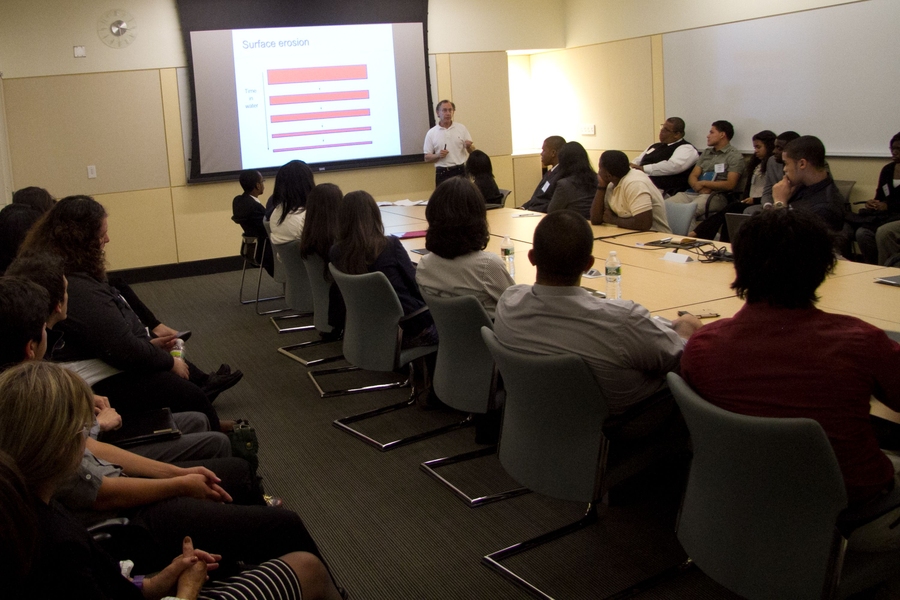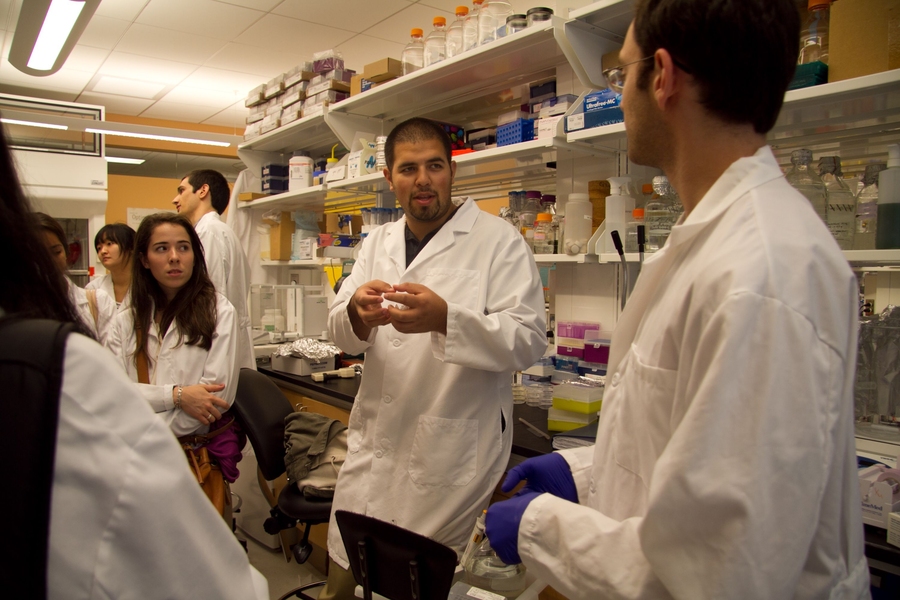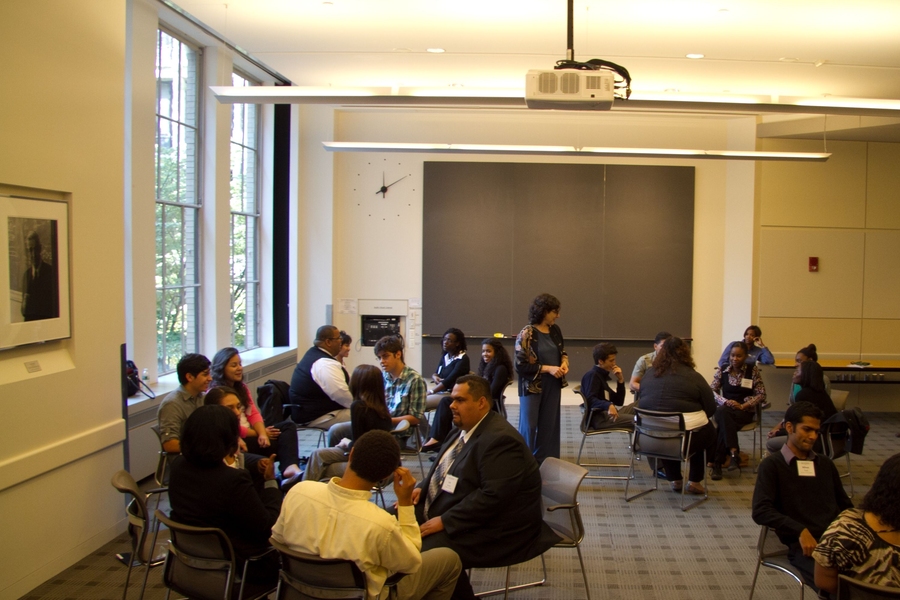From Friday, Sept. 30, through Saturday, Oct. 1, the departments of chemical engineering, chemistry and materials sciences hosted the Dow-MIT Access Program, a weekend of educational and informative events introducing talented sophomores, juniors and seniors to the benefits of a graduate education in chemistry, chemical engineering and materials science. Through interactive workshops, hands-on activities, and engaging presentations on MIT’s campus, 40 under-represented minority students from around the country were introduced to the life of a graduate student in science and engineering.
During the two days, the three departments hosted separate activities geared toward demystifying the application process and graduate student experience. Attendees also came together several times for cross-departmental events, including a presentation by David H. Koch Institute Professor Robert S. Langer.
“During [Professor Langer’s] presentation I got a sense of excitement that I have never felt before toward academics and research in general,” said chemical engineering attendee Mohammed Elzubier from Texas Tech University, “With the help of the Access program, I found out what I wanted to be and how to get there. I feel like my career outlook just took a 180-degree turn and I am very excited for what’s to come in the future.”
The visiting students got to see cutting-edge research by MIT graduate students. In a quantum dot demonstration with chemistry graduate students Darcy Wanger and Jingnan Lu, the attendees observed in real time the growth of quantum dots over the course of the reaction, where the solution started out clear and then turned yellow, orange and finally red as the particles grew. Students who had taken quantum mechanics gave explanations of the “particle in a box” phenomenon and the precipitation purification strategy was demonstrated and explained.
The attendees also spent time with MIT faculty and students. The Department of Materials Science (DMSE) held a “What Goes on Behind Closed Doors” question and answer session — with MIT Professor Krystyn Van Vliet and Professor Andrew Gouldstone of Northeastern University — which provided an inside look to how an admissions committee might analyze application materials. “It was so great to have the opportunity to have our questions answered in such an intimate setting and to get to interact with faculty,” said Camille Martinez, a University of California-Berkeley junior. After meeting DMSE graduate students Sal Barriga and Rodolfo Camacho-Aguilera, fellow attendee Lucas Caretta, a junior at the University of Minnesota, Twin Cities, added, “Hearing from the grad students was really helpful, because they are the ones who are actually living it.”
The mission of the Access program is to increase the diversity of qualified applicants to PhD programs in science and engineering throughout the United States. Originally hosted by the Department of Chemical Engineering, the program was created and funded by the Dow Chemical Company and is based on the company’s highly successful BEST program which offers a similar experience for graduate students wishing to explore industrial careers in science and engineering. With a recent outreach gift from Dow, the program was expanded to include the departments of chemistry and materials science. The goal of Access is not necessarily to prepare students for graduate school at MIT, but rather to introduce them to the advantages of choosing a graduate career path at an institution that best meets each participant’s individual needs.
More information on the Dow-MIT Access Program can be found at http://access.mit.edu/.
During the two days, the three departments hosted separate activities geared toward demystifying the application process and graduate student experience. Attendees also came together several times for cross-departmental events, including a presentation by David H. Koch Institute Professor Robert S. Langer.
“During [Professor Langer’s] presentation I got a sense of excitement that I have never felt before toward academics and research in general,” said chemical engineering attendee Mohammed Elzubier from Texas Tech University, “With the help of the Access program, I found out what I wanted to be and how to get there. I feel like my career outlook just took a 180-degree turn and I am very excited for what’s to come in the future.”
The visiting students got to see cutting-edge research by MIT graduate students. In a quantum dot demonstration with chemistry graduate students Darcy Wanger and Jingnan Lu, the attendees observed in real time the growth of quantum dots over the course of the reaction, where the solution started out clear and then turned yellow, orange and finally red as the particles grew. Students who had taken quantum mechanics gave explanations of the “particle in a box” phenomenon and the precipitation purification strategy was demonstrated and explained.
The attendees also spent time with MIT faculty and students. The Department of Materials Science (DMSE) held a “What Goes on Behind Closed Doors” question and answer session — with MIT Professor Krystyn Van Vliet and Professor Andrew Gouldstone of Northeastern University — which provided an inside look to how an admissions committee might analyze application materials. “It was so great to have the opportunity to have our questions answered in such an intimate setting and to get to interact with faculty,” said Camille Martinez, a University of California-Berkeley junior. After meeting DMSE graduate students Sal Barriga and Rodolfo Camacho-Aguilera, fellow attendee Lucas Caretta, a junior at the University of Minnesota, Twin Cities, added, “Hearing from the grad students was really helpful, because they are the ones who are actually living it.”
The mission of the Access program is to increase the diversity of qualified applicants to PhD programs in science and engineering throughout the United States. Originally hosted by the Department of Chemical Engineering, the program was created and funded by the Dow Chemical Company and is based on the company’s highly successful BEST program which offers a similar experience for graduate students wishing to explore industrial careers in science and engineering. With a recent outreach gift from Dow, the program was expanded to include the departments of chemistry and materials science. The goal of Access is not necessarily to prepare students for graduate school at MIT, but rather to introduce them to the advantages of choosing a graduate career path at an institution that best meets each participant’s individual needs.
More information on the Dow-MIT Access Program can be found at http://access.mit.edu/.









